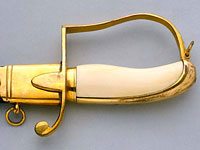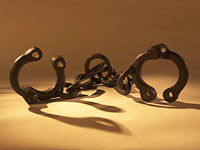
 On the left is a fine etching from the blade of Matthew Flinders’ sword. It was made in Portsmouth, Great Britain, in the late 1700s. This sword, along with Flinders’ cocked hat, naval coat badge and his personal logbooks and papers, were presented to the Library by his grandson in the 1920s.
On the left is a fine etching from the blade of Matthew Flinders’ sword. It was made in Portsmouth, Great Britain, in the late 1700s. This sword, along with Flinders’ cocked hat, naval coat badge and his personal logbooks and papers, were presented to the Library by his grandson in the 1920s.
Flinders was one of the world’s most accomplished navigators. In 1801 he was given command of the Investigator and instructed to examine ‘the unknown coast’. Flinders went on to circumnavigate Australia. On his return journey to England, Flinders’ was accused of espionage by the French and spent more than six years imprisoned in Mauritius. Despite opportunities to escape he refused to break his parole. Finally released, he lived long enough to see his great work, A Voyage to Terra Australis, published in England in 1814, but died the following day.
See more about Flinders’ sword
 Convict leg irons form the curves of the letter B. These heavy metal anklets, connected by chain, restrained a convict’s movements during the years of penal transportation. They were often used to control the gangs building the colony’s first roads through the Australian bush.
Convict leg irons form the curves of the letter B. These heavy metal anklets, connected by chain, restrained a convict’s movements during the years of penal transportation. They were often used to control the gangs building the colony’s first roads through the Australian bush.
See more about convict leg irons